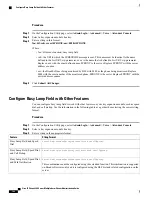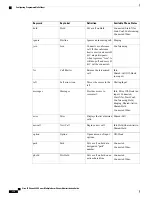
•
PG_PRI_EMERGENT(Priority 0): If the phone receives a page with priority 0 during a call, the call
will be put on hold. After the paging is complete, the call resumes.
•
PG_PRI_IMPRORTANT(Priority 1): If the phone receives a page with priority 1 during a call, the call
and the page audio is mixed.
•
PG_PRI_NORMAL (Priority 2): If the device receives a page with priority 2 during a call, the phone
does not display any incoming page icon on the phone screen and the user only hears a notification tone.
Once the call ends and if the page is still active, the user sees the paging notification on the phone.
•
PG_PRI_MINOR (Priority 3): If the phone receives a page with priority 3 during a call, the page is
ignored.
Procedure
Step 1
In the phone web page, select
Admin Login
>
Advanced
>
Voice
>
Phone
.
Step 2
In the
Multipaging Group Parameters
section, enter a string in this format in the
Group Paging Script
field.
pggrp=multicast-address:port;[name=xxxx;]num=yyy;[listen={yes|no}]];pri=n
where:
•
multicast-address = Multicast IP address of the phone that listens for and receives pages.
•
port = Port on which to page; you must use different ports for each paging group.
•
name (optional) = xxxx is the name of the paging group. Replace xxxx with a name. The name can
consist maximum of 64 characters.
•
num= yyy is a unique number that the user dials to access the paging group. Replace yyy with a number.
The number can consist maximum of 64 characters and the allowed range is 1024 to 32767.
•
listen = Indicates whether the phone listens on the page group. Only the first two groups with listen set
to yes listen to group pages. If the field is not defined, the default value is no, so you must set this field
to listen to the group pages.
•
pri = n indicates the priority level of the paging. Priority level ranges from 0 to 4.
You can add more paging groups by appending to the configuration string and set the paging priority. Here
is an example.
pggrp=224.168.168.168:34560;name=All;num=500;listen=yes;pri=0
pggrp=224.168.168.168:34562;name=GroupA;num=501;listen=yes;pri=1
pggrp=224.168.168.168:34564;name=GroupB;num=502;pri=2
pggrp=224.168.168.168:34566;name=GroupC;num=503;pri=3
This example creates four paging groups: All, GroupA, GroupB, and GroupC. Users dial 500 to send pages
to all phones. If the phone receives a page on the
“
All
”
group during a call, the call will be put on hold.
User dials 501 to send pages to phones configured as part of the GroupA group. If the phone receives a page
on the
“
GroupA
”
group during a call, the audio from page and call will be mixed.
User dials 502 to send pages to phones configured as part of the GroupB group. If the phone configured in
GroupA receives a page during an active call, the paging UI will not show up on the device, and a notification
tone will be played upon receiving the page. Once the active call ends, and if the page is still active, the paging
UI will show up on the device.
Cisco IP Phone 8800 Series Multiplatform Phones Administration Guide
172
Add Priority Paging
Summary of Contents for 8851
Page 23: ...P A R T I About the Cisco IP Phone Technical Details page 9 Cisco IP Phone Hardware page 21 ...
Page 24: ......
Page 36: ...Cisco IP Phone 8800 Series Multiplatform Phones Administration Guide 20 USB Port Information ...
Page 48: ......
Page 98: ......
Page 136: ......
Page 168: ...Cisco IP Phone 8800 Series Multiplatform Phones Administration Guide 152 XML Services ...
Page 204: ...Cisco IP Phone 8800 Series Multiplatform Phones Administration Guide 188 Capture Packets ...
Page 210: ......
















































